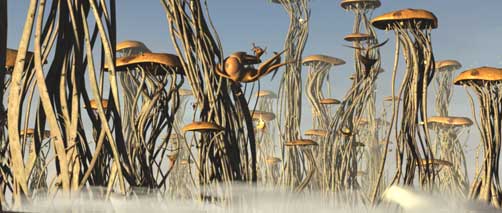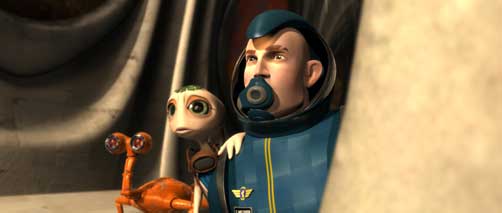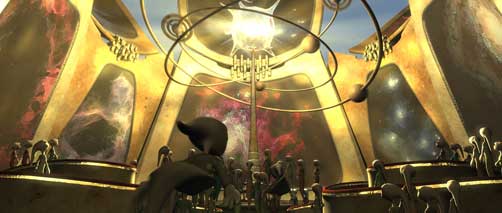Battle for Terra
story by Aristomenis Tsirbas
screenplay by Evan Spiliotopoulos
directed by Aristomenis Tsirbas
starring the voices of (in alphabetical order): Brian Cox, David Cross, Chris Evans, James Garner, Danny Glover, Amanda Peet, Dennis Quaid, Luke Wilson, Evan Rachel Wood
rated PG
85 minutes (animated)
3-D glasses are definitely required for this gorgeously animated film. It’s both technically and visually beautiful.
 Sadly, that’s the best I can say for it. The movie is filled with the self-loathing that characterizes the worst of the environmental movement; it keeps pounding the viewer with the fact that the technologically advanced, warlike humans are bad, but the at-one-with-nature, peace-loving aliens are good. It’s Independence Day, with the humans attacking. But since they are humans, they have to learn better at the end, learn the peaceful naturalists are right and they were wrong.
Sadly, that’s the best I can say for it. The movie is filled with the self-loathing that characterizes the worst of the environmental movement; it keeps pounding the viewer with the fact that the technologically advanced, warlike humans are bad, but the at-one-with-nature, peace-loving aliens are good. It’s Independence Day, with the humans attacking. But since they are humans, they have to learn better at the end, learn the peaceful naturalists are right and they were wrong.
If the film makers weren’t so busy teaching us a lesson, they might have been able to tell a good story, they might have picked up on some of the implausibilities, they might have fixed some of the too-derivative scenes, they might have better gotten their point across. But they didn’t. I felt like the first time I saw the Star Trek: The Next Generation episode “The Drumhead”: I wanted to yell at the screen “We get it! You’re talking about environmentalism (in the Star Trek ep, it was McCarthyism). Now move on, tell us something more.” But the movie keeps coming back, saying “You don’t understand. This is important. We have to live in harmony with nature. Technology is bad.” (Which is kind of ironic, considering how the movie was made.)
The Terrians (the invading humans have named the planet after their own lost home; the natives don’t seem to have named it) live at one with nature, above the clouds. They have no legs, but float in the air (think mermaids), which is wonderful, except that every other life form floating around has wings. They live in elongated, twining, mushroom-shaped buildings, floating or flying at will. The story opens with attendance in an open-air school (The Last Mimzy), and two students are absent. Cut to, the two absent students, racing in home-made ornithopters (they can fly without wings, but they build flying machines with wings). Mala (Evan Rachel Wood) is the brilliant risk-taker, while her friend Senn (Justin Long) is the more conservative follower (so why is he cutting school to race in these flyers?). Mala flies into the very dangerous valley (either Star Wars: A New Hope or Star Wars: The Phantom Menace), and is caught in the wind cavern at the end. Luckily for her, Senn has a grappling hook, and manages to pull her out. Then she flies very near the forbidden zone, but before she can break the taboo, an unexpected eclipse blocks out the sun.
A very mechanical looking spaceship (it’s almost steampunk in its profusion of moving gears and interlocking wheels) has entered the system, and taken up a parking orbit directly between the unnamed Terrian city and the sun. And there it stays, for hours, while the city elders tell the citizens to stay in their homes; everything is fine.
 Well, of course, everything is not fine. Some mechanical things start swarming through the atmosphere—all straight lines and hard edges (as opposed to the smoothly rounded world of Terra). And they steal people just floating along, minding their own business. Horrors! It’s the worst of alien kidnapping, and even worse: it happens during the daytime, when other people can see. And one of the kidnappees is Mala’s father.
Well, of course, everything is not fine. Some mechanical things start swarming through the atmosphere—all straight lines and hard edges (as opposed to the smoothly rounded world of Terra). And they steal people just floating along, minding their own business. Horrors! It’s the worst of alien kidnapping, and even worse: it happens during the daytime, when other people can see. And one of the kidnappees is Mala’s father.
Outgunned and overpowered, the Terrians are not without guile. While trying to get taken by one of the invading ships (in order to find her father), Mala manages to catch the attention of one, which then chases her in her flyer. She leads it hither and yon, and eventually to that dangerous cavern (now it’s Independence Day again), and, well, you can see where this is going. She pulls out in time, the invader doesn’t, and it’s damaged, and crashes. Mala tracks the wreckage down through the cloud layer to see if it can get her father back. Finding the crashed ship, she finds an unconscious invader, and we’re shocked to discover that the interstellar baddies are human. His robotic assistant, a cute little machine (designed for the tie-in marketability) named Giddy (David Cross), instantly co-opts Mala into helping his human survive. It seems his ship is well and truly crashed, and his oxygen supply is running out.
Mala’s a genius, remember, and in the scant time left before his oxygen is depleted, she’ll save his life. Giddy teaches Mala English (direct silicon-brain to meat-brain downloading of data, a la The Matrix, is one of Giddy’s minor abilities). Mala is able to provide Giddy with a wide selection of plants, one of which (wonders!) produces oxygen. Somehow, between “he’ll suffocate” and “he’s dead”, she’s able to produce a dome from which the oxygen won’t escape, airtight tubing to pump in the oxygen, and sufficient plants pumping out sufficient oxygen to keep him breathing.
In and amongst the teaching and building, Giddy is able to tell Mala why the humans are here: their daughter-colonies on Mars and Venus, after 200 years, decided they wanted independence, and the ensuing war destroyed all three planets. The mere handful left on the spaceship are all that remain of humanity (Battlestar Galactica, anyone?).
Miraculously, Lieutenant Jim Stanton (Luke Wilson) wakes up. Giddy explains the situation. Stanton is impressed by Mala’s skills, and tells her she has to help him fix his ship in order to get her father back. It turns out these space-to-atmosphere-and-back fighters, seemingly millennia ahead of the Terrians in terms of technology, run on gears and cog wheels, and with Giddy’s millimeter-precise specifications, Mala is able to carve/cast/build a replacement part to fix Stanton’s ship. The only problem is, his ship has gone missing.
Meanwhile, up in space, General Hemmer (Brian Cox), the very flower of humanity, can’t wait the five minutes it will take for him to step out of the room to allow the Council to vote on his plan to invade Terra (“Don’t wait for the translation! Answer me now!”). Instead, he stages a bloodless coup and orders the full-scale invasion of terraforming of Terra. It was his character I found the least believable. Sure, he’s a driven, military man, and he gives at least lip service to his greater goal of ensuring the survival of the human race. But he is first, last, and only, a parody of the war-mongering mind most the environmental movement assumes the military to be.
 Back below the cloud layer, in the eternal snows that are the surface of Terra, Mala, Giddy, and Stanton return to Stanton’s ship to fix it and get him back into space… only to discover that the ship is missing. Someone’s dragged it away. They track it through the snows, and discover that the Terrians had a more technological past. The forbidden zone is forbidden for a reason (Beneath the Planet of the Apes): the elders have kept their race’s greater knowledge and warlike past a secret from most of their
Back below the cloud layer, in the eternal snows that are the surface of Terra, Mala, Giddy, and Stanton return to Stanton’s ship to fix it and get him back into space… only to discover that the ship is missing. Someone’s dragged it away. They track it through the snows, and discover that the Terrians had a more technological past. The forbidden zone is forbidden for a reason (Beneath the Planet of the Apes): the elders have kept their race’s greater knowledge and warlike past a secret from most of their sheep people, but have retained the knowledge “just in case.” (Mind you, they’re not a spacefaring civilization, and they seem to be the only sentient life on the planet, but they were planning for a war “just in case”.)
They’ve taken Stanton’s ship to see if there’s more they can learn from it, to upgrade their own weapons. But Mala’s got a much bigger goal: she has to rescue her father. So Stanton, Mala, and Giddy steal Stanton’s ship out of the underground hangar and head up into space.
“Congratulations, Lieutenant, you’re a war hero,” says the general.
“Uh, it’s not like that sir,” says Stanton.
“Yes it is,” says the general, “and now you’re going to lead the invasion. But first, prove your loyalty: save your brother’s life by killing Mala.”
And the invasion begins. The fighter craft are all there to protect the terraformer: one big oxygen-generation plant that is wearing out on the spaceship, so that the humans in space have less than a month’s worth of breathing left. But if they land it on the planet, it can provide an entire breathable planetary atmosphere in a matter of hours (incidentally killing the natives). And once again, to prove their self-loathing, the oxygen it pumps out is a nauseating green smog, desecrating the lovely world.
Well, you know where this is going: the natives are more than they seem, but still at one with nature. The humans are bad, stupid, and destined to fail, and they do. But it takes one human seeing right from wrong to turn on his sick-minded leaders.
Cut to: sometime later. And the humans have finally realized that there is a way to live in peace with the Terrians, and they’ve got a little space for themselves, and all is right with the world.
Simplistic, awkward, I’m grumpy because it could have been a much better movie with just a little more work at the beginning. That’s perhaps the most frustrating part: the problems were fixable, but they were ignored.
For adults, a disappointing movie. But for kids, maybe not so bad. For the other half of my mind, see this addendum.